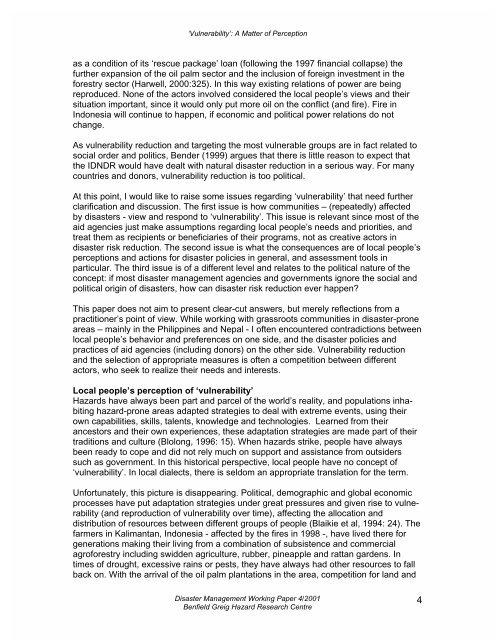'Vulnerability': A Matter of Perception - nirapad
'Vulnerability': A Matter of Perception - nirapad
'Vulnerability': A Matter of Perception - nirapad
Create successful ePaper yourself
Turn your PDF publications into a flip-book with our unique Google optimized e-Paper software.
‘Vulnerability’: A <strong>Matter</strong> <strong>of</strong> <strong>Perception</strong>as a condition <strong>of</strong> its ‘rescue package’ loan (following the 1997 financial collapse) thefurther expansion <strong>of</strong> the oil palm sector and the inclusion <strong>of</strong> foreign investment in theforestry sector (Harwell, 2000:325). In this way existing relations <strong>of</strong> power are beingreproduced. None <strong>of</strong> the actors involved considered the local people’s views and theirsituation important, since it would only put more oil on the conflict (and fire). Fire inIndonesia will continue to happen, if economic and political power relations do notchange.As vulnerability reduction and targeting the most vulnerable groups are in fact related tosocial order and politics, Bender (1999) argues that there is little reason to expect thatthe IDNDR would have dealt with natural disaster reduction in a serious way. For manycountries and donors, vulnerability reduction is too political.At this point, I would like to raise some issues regarding ‘vulnerability’ that need furtherclarification and discussion. The first issue is how communities – (repeatedly) affectedby disasters - view and respond to ‘vulnerability’. This issue is relevant since most <strong>of</strong> theaid agencies just make assumptions regarding local people’s needs and priorities, andtreat them as recipients or beneficiaries <strong>of</strong> their programs, not as creative actors indisaster risk reduction. The second issue is what the consequences are <strong>of</strong> local people’sperceptions and actions for disaster policies in general, and assessment tools inparticular. The third issue is <strong>of</strong> a different level and relates to the political nature <strong>of</strong> theconcept: if most disaster management agencies and governments ignore the social andpolitical origin <strong>of</strong> disasters, how can disaster risk reduction ever happen?This paper does not aim to present clear-cut answers, but merely reflections from apractitioner’s point <strong>of</strong> view. While working with grassroots communities in disaster-proneareas – mainly in the Philippines and Nepal - I <strong>of</strong>ten encountered contradictions betweenlocal people’s behavior and preferences on one side, and the disaster policies andpractices <strong>of</strong> aid agencies (including donors) on the other side. Vulnerability reductionand the selection <strong>of</strong> appropriate measures is <strong>of</strong>ten a competition between differentactors, who seek to realize their needs and interests.Local people’s perception <strong>of</strong> ‘vulnerability’Hazards have always been part and parcel <strong>of</strong> the world’s reality, and populations inhabitinghazard-prone areas adapted strategies to deal with extreme events, using theirown capabilities, skills, talents, knowledge and technologies. Learned from theirancestors and their own experiences, these adaptation strategies are made part <strong>of</strong> theirtraditions and culture (Blolong, 1996: 15). When hazards strike, people have alwaysbeen ready to cope and did not rely much on support and assistance from outsiderssuch as government. In this historical perspective, local people have no concept <strong>of</strong>‘vulnerability’. In local dialects, there is seldom an appropriate translation for the term.Unfortunately, this picture is disappearing. Political, demographic and global economicprocesses have put adaptation strategies under great pressures and given rise to vulnerability(and reproduction <strong>of</strong> vulnerability over time), affecting the allocation anddistribution <strong>of</strong> resources between different groups <strong>of</strong> people (Blaikie et al, 1994: 24). Thefarmers in Kalimantan, Indonesia - affected by the fires in 1998 -, have lived there forgenerations making their living from a combination <strong>of</strong> subsistence and commercialagr<strong>of</strong>orestry including swidden agriculture, rubber, pineapple and rattan gardens. Intimes <strong>of</strong> drought, excessive rains or pests, they have always had other resources to fallback on. With the arrival <strong>of</strong> the oil palm plantations in the area, competition for land andDisaster Management Working Paper 4/2001Benfield Greig Hazard Research Centre4












